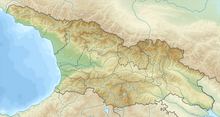Battle of Chikhori
| Battle of Chikhori | |||||||
|---|---|---|---|---|---|---|---|
| Part of Georgian civil war of 1463–1491 | |||||||
| |||||||
| Belligerents | |||||||
|
|
| ||||||
| Commanders and leaders | |||||||
| Bagrat II of Imereti | George VIII | ||||||
Location of Chikhori in modern Georgia with present-day administrative borders. | |||||||
The Battle of Chikhori was fought between the armies of King George VIII of Georgia and the rebellious nobles led by a royal kinsman Bagrat in 1463. It took place near the fortress Chikhori in the district of Argveti in western Georgia, and ended in the king's decisive defeat.
History[edit]
Unity within the Georgian states disappears after the failure of George VIII's diplomatic mission. Qvarqvare II Jaqeli formally remains the king's subject and partner, but begins to encourage Duke Bagrat of Samokalako to revolt against George VIII.[1] The latter is himself heir to the Bagrationi dynasty of Western Georgia, the eldest branch of the royal family whose last sovereign, Constantine II of Imereti, was overthrown by George VII in 1401, and began to claim the throne of his ancestors.[2] The latter being the uncle of George VIII, the nobility of Imereti did not suspect Bagrat of separatism,[3] but the latter was soon encouraged by the powerful of western Georgia.
In addition to Samtskhe-Saatabago, Bagrat allied himself with Liparit I Dadiani, Mamia Gurieli and the princes of Abkhazia[4] and Svaneti,[5] to whom he promised to free them from all central imposition.[6] Together, the rebels captured numerous fortresses across Imereti in 1462,[3] after which George VIII abolished the Duchy of Samokalako and decided to intervene.[2] In 1463, the king crossed the Likhi range and requested military aid from Samtskhe, of whose loyalty he was convinced.[7] Qvarqvare II landed in Imereti with his troops but camped far from the conflict zone, waiting to see the winner.[7] This reaction is widely seen as direct aid to the separatists.[8]
George VIII and Bagrat clashed at Chikhori, during which the rebels inflicted a decisive defeat on the forces of the central government.[6] King George retreated towards Kartli[8] and severely punished the nobility whom he did not consider faithful enough.[9] Bagrat captured Kutaisi,[5] the largest city in western Georgia, and is crowned king of Imereti as Bagrat II[8] in front of the great nobility of Mingrelia, Guria, Abkhazia, Samtskhe and Svaneti, but its power remains weak, including within its capital.[10] The Battle of Chikhori signals the beginning of the fall of the Kingdom of Georgia: the Georgian kings will never again control the whole of Georgia.
Bagrat created a principality for each of his allies:[11][12]
- Principality of Svaneti for the House of Gelovani;
- Principality of Abkhazia for the Sharvashidze;
- Principality of Mingrelia for the Dadiani;
- Principality of Guria for the Vardanidze-Gurieli.
References[edit]
- ^ Brosset 1858, pp. 207–208.
- ^ a b Salia 1980, p. 265.
- ^ a b Brosset 1858, pp. 249–250.
- ^ Asatiani 2008, p. 121.
- ^ a b Brosset 1849, p. 646.
- ^ a b Rayfield 2012, p. 160.
- ^ a b Brosset 1858, p. 208.
- ^ a b c Brosset 1858, p. 250.
- ^ Asatiani & Janelidze 2009, p. 121.
- ^ Salia 1980, p. 266.
- ^ Suny, Ronald Grigor (1994), The Making of the Georgian Nation: 2nd edition. Indiana University Press, ISBN 0-253-20915-3
- ^ Toumanoff, Cyril (1949–51). The Fifteenth-Century Bagratids and the Institution of Collegial Sovereignty in Georgia. Traditio 7: 192.
42°14′24″N 43°4′12″E / 42.24000°N 43.07000°E
Bibliography[edit]
- Asatiani, Nodar; Janelidze, Otar (2009). History of Georgia. Tbilisi: Publishing House Petite. ISBN 978-9941-9063-6-7.
- Brosset, Marie-Félicité (1849). Histoire de la Géorgie depuis l'Antiquité jusqu'au XIXe siècle. Volume I [History of Georgia from Ancient Times to the 19th Century, Volume 1] (in French). Saint-Petersburg: Imperial Academy of Sciences.
- Brosset, Marie-Félicité (1858). Histoire moderne de la Géorgie. Saint-Pétersbourg: Imprimerie de l'Académie impériale des sciences.
- Rayfield, Donald (2012). Edge of Empires, a History of Georgia. London: Reaktion Books. ISBN 978-1-78023-070-2.
- Salia, Kalistrat (1980). Histoire de la nation géorgienne [History of the Georgian nation] (in French). Paris: Nino Salia.
- Asatiani, Nodar (2008). Საქართველოს ისტორია II [History of Georgia, Volume 2] (in Georgian). Tbilisi: Tbilisi University Press. ISBN 978-9941-13-004-5.

